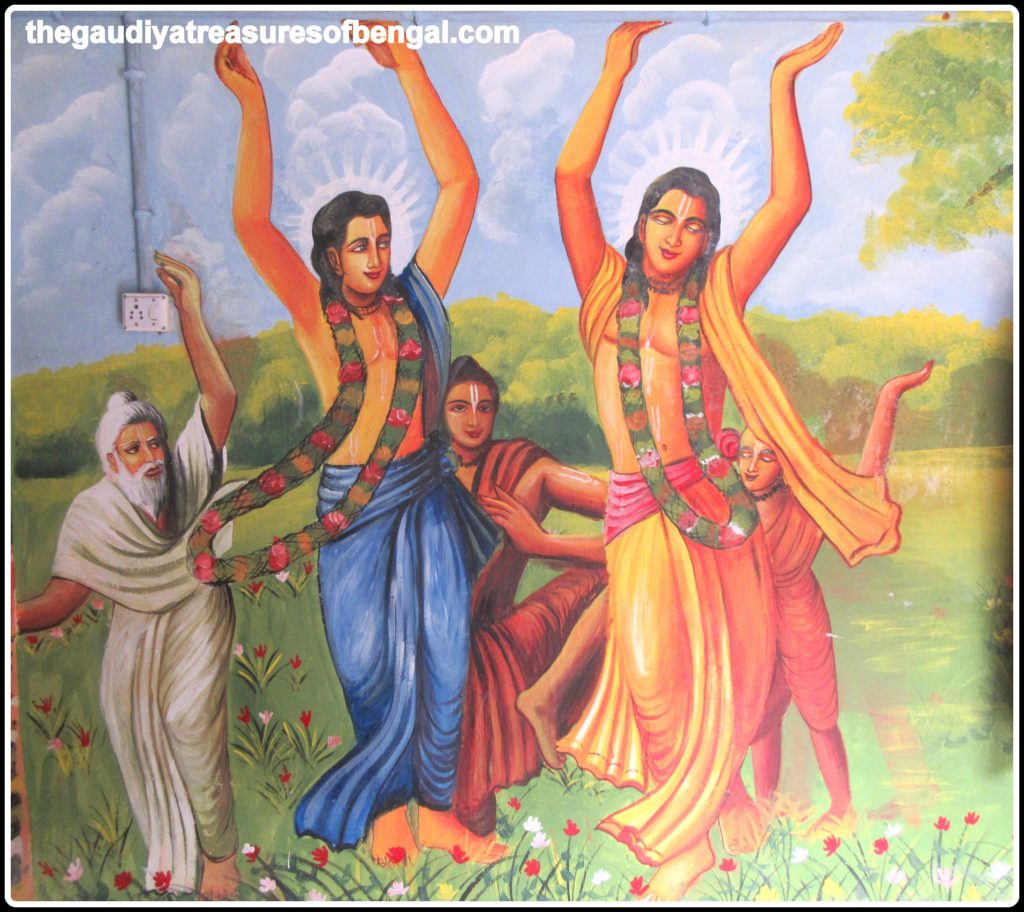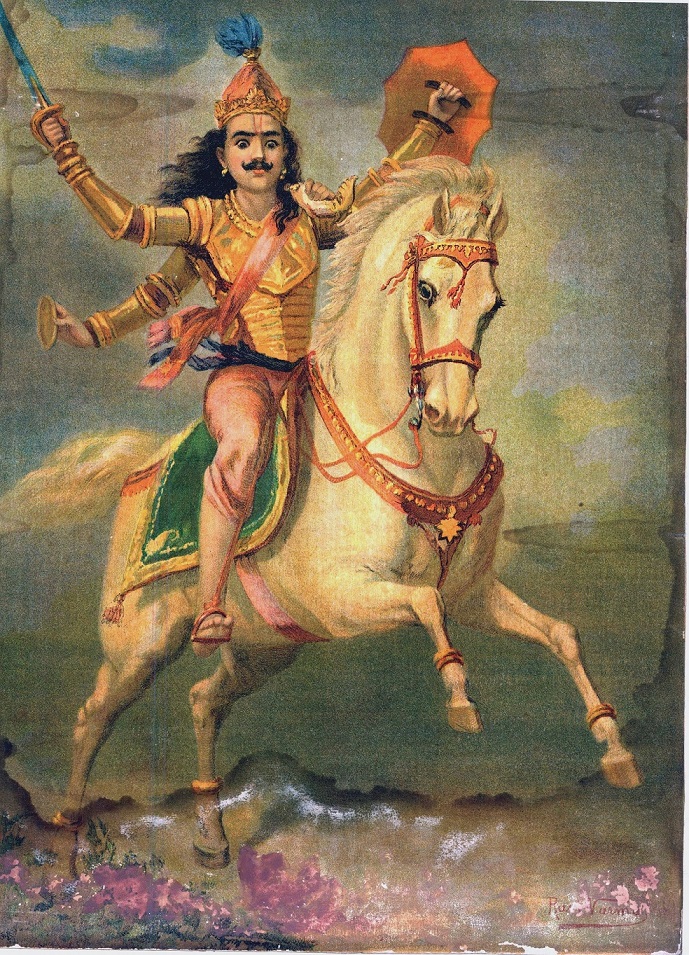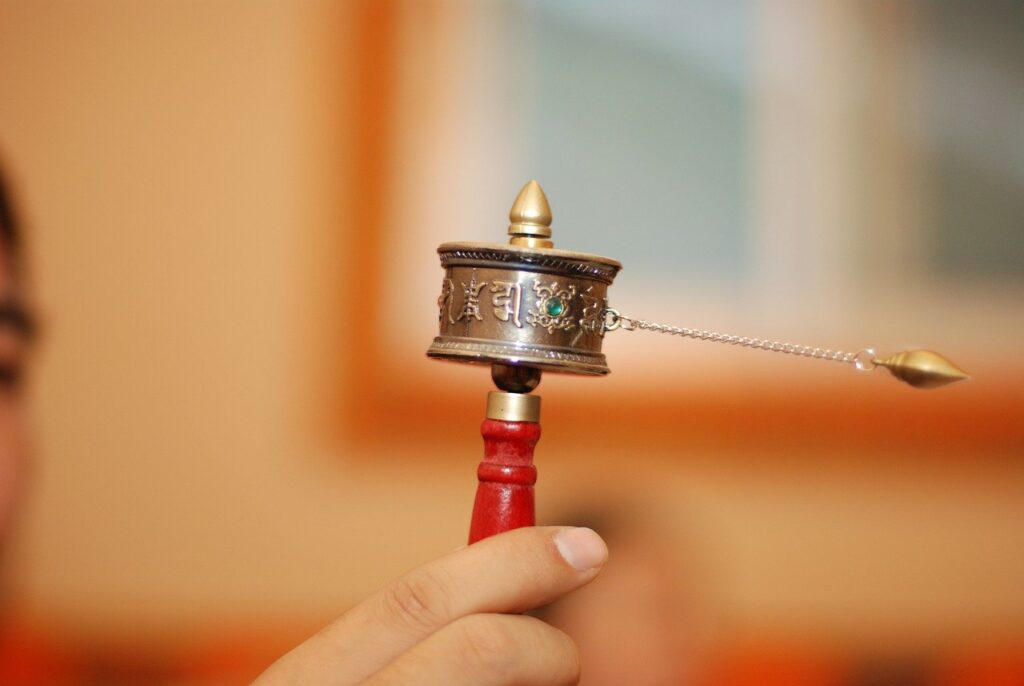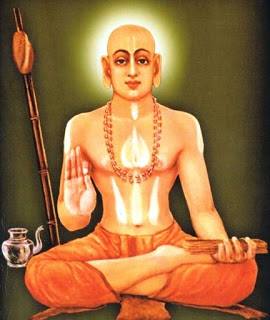Read more about the life and pastimes about Rasikananda Murari and his Sripat at Gopiballavpur – https://thegaudiyatreasuresofbengal.com/2019/02/10/gopiballavpur-preaching-headquarters-sri-rasikananda-murari/
Month: May 2021

Sri Chaitanya Mahaprabhu, the Supreme Personality of Godhead ,had mercifully appeared at Yogpeeth (in Mayapur, West Bengal, India) about 500 years ago (in the year 1486 AD), to bless us with the most wonderful, deep and ecstatic pastimes of Gaura lila. The identity of Lord Chaitanya Mahaprabhu as the Supreme Personality of Godhead can be verified in a number of Vedic scriptures like Srimad Bhagavatam, Mahabharata, Garuda Purana, Nrsimha Purana, Padma purana, Bhavishya Purana, Narada Purana etc. Sri Chaitanya Mahaprabhu is the most munificent incarnation of the Supreme. Lord Gaurahari freely gives what no other incarnation of the Supreme Lord has ever given before – the ecstatic pure love of God. He does not consider one’s qualifications or background or pedigree before bestowing this supreme gift upon them, receiving which one achieves the ultimate perfection of his human life. This ecstatic love of God eludes the great demigods like Brahma, Shiva and Indra. Even Lakshmi devi, the wife of Lord Narayana, hankers to receive it. A yogi cannot achieve it , even after performing severe austerities for thousands of years. A Jnani cannot smell it even after analysing the whole of the vedic scriptures. This ecstatic love of God is extremely rare but it can be easily achieved by the causeless mercy of Lord Gauranga. That is why lord Chaitanya is known to be the essence of all the other incarnations of the Supreme – ‘Avatara sar Gaura avatara’. Although being the Supreme Personality of Godhead Himself and having broadcasted the congregational chanting of the holy names of Krishna in all four directions, he did not pen any transcendental literatures Himself, but rather empowered his associates like Sri Rupa and Sanatan Goswamis to compose various literatures on devotion. It was through them that he expounded the science of bhakti (devotional service) and glorified Lord Krishna, the Supreme Personality of Godhead. The only work that is known to have been penned by him is the famous eight verses of Shikshashtakam. Sri Shikshashtakam carries the essence of the entire process of devotional science (Bhakti) from the very basics up to the highest goal of Krishna Prema (unconditional selfless devotional service unto Krishna). It can be stated without uncertainty that whoever deeply studies these instructions of Chaitanya Mahaprabhu, follows them, and imbibes them to their heart, has indeed been blessed with a higher understanding of the path of Bhakti. These glorious shlokas are as follows :
 #1 Who is Kalki Avatar ? – Birth, Family and Mission
#1 Who is Kalki Avatar ? – Birth, Family and Mission
There are many avatars or incarnations of the Supreme Lord as stated in Srimad Bhagavatam (1.3.26): “O Brahmanas, the incarnations of the Lord are innumerable, like rivulets flowing from inexhaustible sources of water”. However, Krishna is the fountainhead of all these incarnations of the Supreme. This has been confirmed in Srimad Bhagavatam (1.3.28) – “ete camsa kalah pumsah, krishnas tu bhagavan svayam,” which means that all the other incarnations are either plenary portions or plenary portions of the plenary portions of the Supreme Lord. However Lord Krishna is the original Supreme Personality of God.
The Supreme Lord descends into this material world time and time again to manifest His pastimes and associate with His intimate devotees. A secondary reason for His appearance is also to annihilate miscreants and rid the world of their disturbance. It has been predicted in various scriptures that at the end of the age of Kali, Kalki avatar will make His appearance to annihilate the miscreants and re-establish the postulates of eternal religion. He shall appear as the son of Vishnuyasha, an eminent brahmana of a village named Shambhala.
![]()
Athasau yuga sandhayam
Dasyu prayesu rajasu
Janita vishnu yasaso
Namna kalkir jagat patih
(Srimad Bhagavatam 1.3.25)
–
Thereafter, at the conjunction of two yugas (Kali and Satya), the Lord of the creation will appear as the Kalki Avatar and become the son of Vishnuyasha. At this time the rulers of the earth will have degenerated into plunderers

Dharma is often interpreted as “duty,” “religion” or “religious duty” and yet its definition is more profound, defying the concise English translation. The word ‘Dharma’ originates from the Sanskrit root “dhri,” which means “to sustain.” Another correlated meaning of ‘Dharma’ is ‘that which is indispensable and fundamental to something’. The word ‘Sanatan’ translates to ‘eternal’ and the phrase ‘Sanatan Dharma’ alludes to that which is eternally integral to a living entity. Likewise, ‘Sanatan Dharma’ commonly refrred to as ‘Hinduism’ today, is timeless, non-sectarian and not limited by any boundaries. Religion conveys the idea of faith, and the faith of a person may change. But ‘Sanatan Dharma’ is that which cannot be changed. That which is ‘Sanatan’ does not have either a beginning or an end. So that brings us to our questions – Who is the founder of Hinduism (Sanatan Dharma) ? What is the origin of Sanatan Dharma ?

The meaning of the Hare Krishna Mahamantra is explained by Sri Gopal Guru Goswami, who was a disciple of Vakreswar Pandita, in the following way :
The transcendental name of Hari, much like fire that burns an object upon contact, has the power to eradicate or “burn up” all the sins of those who are caught up in materialistic pursuits. This divine name not only removes ignorance but also reveals the blissful form of the Lord. Hari, as a term, refers to an enchanting personality whose divine qualities captivate the minds of all beings in the universe. His youthful, beautiful form is so attractive that even the Cupids are mesmerized by it. The term “Hare” is the vocative form of Hari.
In addition to its other meanings, the term “Hare” can also refer to Hara or Srimati Radhika, the daughter of Vrishabhanu. She is known for stealing the mind of Hari during the rasa dance with her beautiful form and loving affection. The term “Hare” is the vocative form of Hara.
The term “Krishna” is derived from the root “Krs,” which means “all-attractive,” and “na,” which refers to “supreme bliss.” When combined, they form the word “Krishna,” which represents the all-attractive and supremely blissful Supreme Personality of Godhead, Sri Krishna. He is also known as Nandanandana and Sri Govinda, with lotus-like eyes and a dark blue complexion. For the Vrajavasis, Krishna is the sole source of bliss.
The term “Rama” implies “ramante,” meaning the embodiment of unlimited pleasure. Sri Krishna, who is highly skilled in loving affairs and is worshiped for His amorous pastimes, always takes pleasure in the company of Radha. This is why He is referred to as Rama (Radharamana Rama).
The supreme brahman is also recognized as ‘Rama’, as yogis find joy in contemplating His eternal, blissful form.
Hare Krishna Hare Krishna Krishna Krishna Hare Hare
Hare Rama Hare Rama Rama Rama Hare Hare
O Radha, please draw my mind towards you and release me from the material world.
O Krishna, please attract my mind to you.
O Radha, captivate my heart with your sweetness.
O Krishna, purify my mind by imparting the knowledge of how to worship you through your pure devotee.
O Krishna, grant me the firmness to appreciate your name, qualities, and pastimes.
O Krishna, may I develop a taste for serving you.
O Radha, make me eligible to serve you.
O Radha, teach me how I can serve you.
O Radha, let me hear about your intimate pastimes with your beloved.
O Rama (Krishna), let me hear about your intimate pastimes with your beloved.
O Radha, reveal your pastimes with your beloved to me.
O Rama, reveal your pastimes with your beloved to me.
O Rama, engage me in remembering your name, form, qualities, and pastimes.
O Rama, make me eligible to serve you.
O Radha, be pleased with me.
O Radha, be pleased with me.
Hare Krishna Mahamantra – further explained
#1 The holy name of Krishna is transcendentally blissful and bestows all spiritual benedictions for it is Krishna Himself, the reservoir of all pleasure. Krishna’s name is complete and is the form of all transcendental mellows. The holy name of Krishna is not material and is no less powerful than Krishna Himself. Krishna and Krishna’s names are identical and are hence free from any material laws or material qualities. Hence Krishna’s names are always liberated and spiritual. In this article we are going to discuss about the Hare Krishna Mahamantra, its Meaning, glories and significance.

Book Price : 9.50 $ (Outside India) / 365 INR (within India)
Please refer to the provided links below to access the most up-to-date prices, as they may have been revised.
(Detailed Book Description provided below)
Book Purchase Links :

Sri Pundarika Vidyanidhi, and the two brothers – Mukunda Datta and Vasudeva Datta, had originally hailed from Chittagong, Bangladesh. They were intimate associates of Sri Chaitanya Mahaprabhu and had appeared to assist Him in his magnanimous pastimes. Kavi Karnapura reveals in Gaura Ganoddesha Dipika that Sri Pundarika Vidyanidhi was the incarnation of Vrishabhanu Maharaj, the father of Srimati Radharani. While Mukunda Datta and Vasudeva Datta were the incarnations of the singers Madhukantha and Madhuvrata respectively. Lord Gauranga and Nityananda loved dancing to the tunes of Vasudeva and Mukunda Datta’s melodious songs.

A brahmana named Keshavacharya, a descendent of Harita, the compiler of Dharma Shastras, lived in a village named Sriperumbudur (Mahabhuta Puri) situated about twenty-six miles from Madras (Chennai). Keshava and his wife Kantimati were pious and possessors of all good qualities. One day, desiring to have a son, they bathed in the river Kairavani and prayed to the Supreme Lord. Lord Hari being pleased with them soon fulfilled their desire. During those days, the land of Bharata-Varsha suffered from a lack of devotion to the Supreme Lord Vishnu. People were largely opposed to the principles of devotional science. To deliver the land of Bharata (India), Lord Hari empowered a suitable entity with the potency of His sankarsana to usher in an age of devotion. Thus Sri Ramanujacharya was born in the year 1017 AD to Keshavacharya and Kantimati devi on a Thursday during the period of Adra Nakshatra in the village of Mahabhuta Puri. He became the acharya of the Sri Vaishnava sampradaya and the proponent of Visistadvaita philosophy.
Read more about Srila Narottam das Thakur and Sripat Kheturi – https://thegaudiyatreasuresofbengal.com/2018/09/03/kheturi-rajshahi-bangladesh-sripat-sri-narottama-das-thakura/

Narayana Bhatta, a pious brahmana who had hailed from the exalted Madhyageha family, lived with his wife Vedavati at Pajaka Kshetra on the shores of the Papanasini river. This place is situated by the Vimanagiri mountains on the southeast of Udupi Kshetra (Karnataka, South India) and is famed to be the place where Lord Parasurama had created holy tirthas. In due course of time, Narayana Bhatta and Vedavati devi had two sons but unfortunately, both died prematurely. The brahmana couple, then being bereft of any progeny, performed severe austerities for twelve years while subsisting only on milk. They yearned to have an immortal son. The Supreme Lord was pleased with their austerities and wanted to reward them. This was the time when pure devotional service was scarce all over Bharata-Varsha. Sanatana Dharma was on the decline while atheism, in the form of Buddhism, and covered atheism, in the form of Shankaracharya’s Mayavada, was forcibly pushing people towards existence in dense ignorance. To revive Sanatana Dharma and its essence of pure devotional service, Vayu, the demigod of wind, appeared in this world by the divine will of Lord Vishnu. Just as he had previously appeared as Hanuman in Treta Yuga and as Bhima in Dvapara Yuga, similarly, Vayu appeared as Sri Madhvacharya (Purnaprajna) in this age of Kali from the womb of mother Vedavati. He was born in 1238 AD, on the auspicious occasion of Vijayadashami, and he was named Vasudeva.